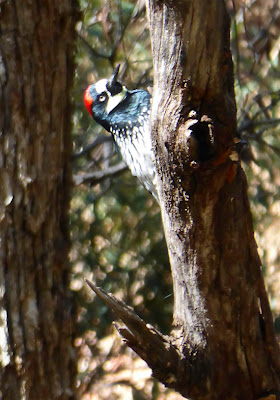This year, again, Alan and I joined the national ritual of Christmas Bird Counts, once more participating in the back-to-back counts for Portal, Arizona, and the Peloncillo Mountains, New Mexico. The weather couldn't have been finer, with temperatures rising into the high 60s and low 70s.
The Portal count, coordinated by Jackie Lewis, was on Saturday. We hiked out our door and up to the high base of Portal Peak, a big bowl full of old-growth Arizona Madrone trees. Away from the canyon bottoms, much of our territory burned last May during the Horseshoe Two fire. Some regrowth has begun, but a lot of it still looks like the Desolation of Smaug.
Trudging through the Desolation, heading for that ribbon of green at the foot of Portal Peak (All photos except oriole by Narca)
Happily, many of the big madrones had weathered last year's drought, freeze and fire, although only a few still bore fruit this day.
An ancient Arizona Madrone, partly burned out, is sprouting new branches. Go, Life!
Junipers are way off in their cycle! We saw almost no berries (and a corresponding lack of berry-eaters like Sage Thrashers and Phainopeplas), and many junipers were
peaking in their pollen production! Who ever heard of juniper pollen at the end of
December?? Late February is more normal. Clouds of orange pollen were wafting on light breezes, creating a very sneezy CBC. Come on, hay fever in December?
This especially bright Say's Phoebe was flycatching within the Desolation.
The Vesper Sparrows surprised me by being in the burned area, higher on the mountain than they usually winter.
Several friends joined us––Skip from Maine, Linda from Idaho, Brad from Tucson––and here is Brad's photo of a highlight for our territory, an adult male Scott's Oriole, in all his finery. We've never before recorded one in our yard in December! I don't know whether Mr Scott is very late, or very early.
Scott's Oriole near Portal, AZ (Photo by Brad Tatham)
Sunday's Peloncillo count, coordinated by Nick Pederson, includes the north end of the Animas Valley, where the Diamond A Ranch (formerly Gray Ranch) allows entry for the CBC counters. Our territory was south of Dunagan's Crossing, from the hackberries through Middle Well, for those who know this valley. This part of the ranch had obviously endured a dry summer, and bird numbers were very low. (Other parts of the count circle fared better.)
The Peloncillo count has always shown boom-and-bust cycles, in synchrony with rain and drought. Once in a span of two years, we went from having the all-time national high for Brewer's Sparrows to zero! Such huge fluctuations emphasize why studies of wildlife in desert regions must be long-term to be truly relevant.
This cryptic Great Horned Owl was roosting in an old hackberry tree. He's hoping we don't see him!
Great Horned Owl in the Animas Valley, New Mexico
The Lark Buntings were also fun, as they picked through horse droppings in search of goodies. This male shows a trace of his classy black breeding dress around his bill.
Lark Bunting looking for a snack






















